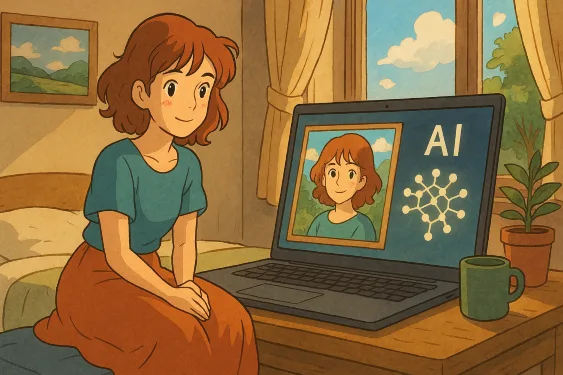In the ever-evolving world of artificial intelligence, creativity and technology are merging in fascinating ways. One of the latest viral sensations to emerge from this intersection is the “Ghibli Trend,” also referred to as “Ghiblification” or “The Ghiblification Phenomenon”. This trend has taken the internet by storm, with users leveraging AI tools like ChatGPT to generate Studio Ghibli-inspired art, transforming ordinary images into the enchanting, hand-painted aesthetic of Hayao Miyazaki’s beloved films. But what exactly is the Ghibli trend, and why has it captured the imagination of millions? Let’s dive deep into this AI-powered phenomenon.
What is the ‘Ghibli Trend’?
The Ghibli trend, or “Ghiblification,” refers to the transformation of real-world imagery, photos, or concepts into artwork that mimics the iconic visual style of Studio Ghibli films. These movies—such as My Neighbor Totoro, Spirited Away, Howl’s Moving Castle, and Princess Mononoke—are known for their breathtaking animation, warm color palettes, and whimsical details.
With the advent of AI-powered image generation tools, users have started utilizing ChatGPT, DALL·E, and similar platforms to reimagine everyday life through a Studio Ghibli lens. The result? Stunning, dreamlike renditions of cities, people, and nature, evoking nostalgia and the signature charm of Miyazaki’s works.
How ChatGPT and AI Image Generation Drive the Trend
While ChatGPT itself does not create images, users are employing AI-powered tools such as DALL·E, MidJourney, and Stable Diffusion to bring Ghibli-style imagery to life. Here’s how the process typically unfolds:
- Prompt Engineering – Users provide detailed text prompts in AI art generators, describing a scene as if it belongs in a Studio Ghibli film. They often include descriptions of soft lighting, painterly brush strokes, lush environments, and vibrant colors.
- AI Interpretation – The AI processes the prompt and generates an image based on learned patterns from similar artwork, often replicating the gentle, fantasy-like aesthetic of Ghibli films.
- Refinement & Sharing – Many users refine their AI-generated images using additional tools or Photoshop, then share them across social media platforms, where the trend continues to grow.
Why is the Ghibli Trend So Popular?
The Ghibli trend resonates with people for multiple reasons:
- Nostalgia & Comfort: Studio Ghibli films hold a special place in the hearts of millions. Their soft, whimsical style evokes a sense of peace, making AI-generated Ghibli-style images feel familiar and heartwarming.
- Creativity Without Limits: AI-powered tools allow users to create stunning art without requiring traditional drawing skills, democratizing digital artistry.
- Social Media Virality: Platforms like Twitter, Instagram, and TikTok have amplified the trend, as users showcase their AI-generated Ghibli landscapes, self-portraits, and fantasy settings.
- Escape from Reality: The ethereal worlds of Studio Ghibli offer a form of escapism. By “Ghiblifying” real-life images, people can momentarily step into a more magical version of their own world.
The Drawbacks of the Ghibli Trend
While the Ghibli trend is a fun and creative way to experiment with AI-generated art, there are some notable drawbacks:
- Privacy Concerns: Many users are sharing their personal images, including selfies and family photos, with AI platforms. This raises questions about how these images are stored, used, or even repurposed without consent.
- Data Security Risks: AI tools require vast amounts of data to improve their capabilities. By uploading personal photos, users might unknowingly be contributing to AI training datasets, leading to potential misuse.
- Deepfake and Identity Theft Risks: AI-generated images can be manipulated in ways that may lead to deepfake-related concerns, where realistic but artificially created images can be misused for malicious purposes.
- Lack of User Control: Once an image is uploaded and processed by an AI tool, the user might lose control over where and how that image is used, especially on platforms with unclear data policies.
The Ethics and Challenges of AI-Generated Art
Despite its popularity, AI-generated Ghibli-style art has sparked debates about the ethics of AI in creative fields. Some key concerns include:
- Intellectual Property Issues: Studio Ghibli’s unique style is a product of human artistry, and some argue that AI tools may inadvertently borrow from copyrighted material.
- Impact on Human Artists: While AI makes art more accessible, some fear that it could undermine the value of human illustrators, potentially replacing commissioned work with AI-generated alternatives.
- AI Bias and Limitations: AI is not perfect—it may misinterpret prompts, create unrealistic images, or struggle with certain stylistic nuances that human artists excel at.
The Future of AI in Art and Animation
The Ghibli trend highlights the growing influence of AI in artistic expression. As AI continues to evolve, we may see:
- More Advanced AI-Generated Art Tools – AI models will likely improve their ability to capture nuances of different artistic styles, making them even more indistinguishable from human-created works.
- Collaboration Between AI and Artists – Instead of replacing human creativity, AI could become a tool that assists artists, helping them conceptualize and refine ideas more efficiently.
- Interactive AI Storytelling – Future developments might allow users to generate entire animated sequences in a Ghibli-like style, blurring the line between user-generated content and professional animation.
Conclusion: A Beautiful Blend of Tech and Art
The Ghibli trend is a testament to the magic that happens when technology meets imagination. While AI cannot replicate the soul and emotion of a Miyazaki film, it can bring fans closer to experiencing their own Ghibli-like world. Whether you see AI-generated art as a tool or a challenge to traditional creativity, one thing is certain: the Ghiblification phenomenon is here to stay, and it’s painting the digital world with nostalgia and wonder.
